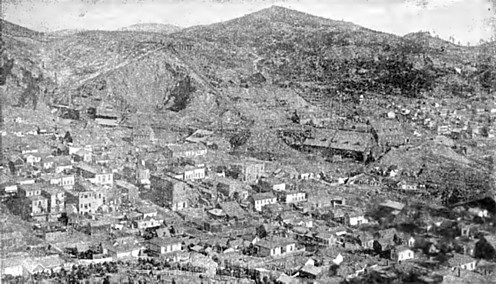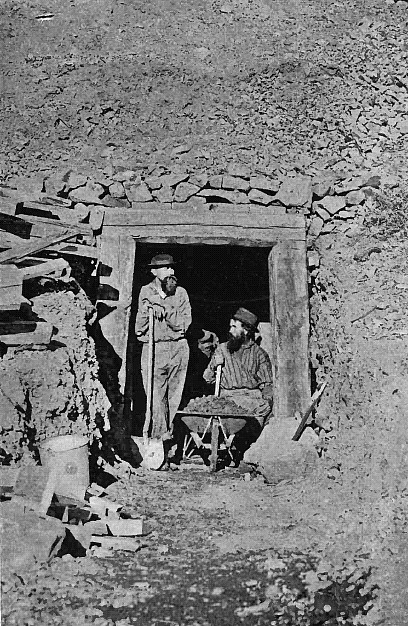The Custer City Mining District is looming up with astonishingly rich discoveries, and some of the richest quartz in the Black Hills has been discovered in the district. The town is waking up from its long sleep, and bids fair to rival the other cities of the Hills. The Atlantic Mine Custer District. "The Atlantic" mine, in the vicinity of Custer, is a famous gold lode of great richness. The district in which it is situated is about five miles north-west of Custer City. The quartz is entirely different from that found in the vicinity of Deadwood and the northern hills, being more like the California and Arizona type of quartz. The "Old Bill" Lode has a main shaft sunk thirty feet, and ore is being extracted of great richness. The "Grand Junction" mine, which is a mile west of the Old Bill, has a shaft down fifty feet and cross-cuts showing a body of ore eighty feet in width which is said to mill fifty dollars per ton. The extension, of the Grand Junction on the south prospects equally as well.
The Atlantic Mine, however, was first discovered in this district, and is decidedly the richest. This mine has a tunnel seventy feet long, connecting with a main shaft forty-nine feet deep. The tunnel cross-cuts the ledge, showing a well-defined vein of gold ore thirty feet wide that will mill, it is said, over one thousand dollars per ton. There was obtained from one pan full of earth and rock, two dollars in gold dust, and several free gold quartz specimens. A pan full of this crevice matter yielded, it is said, about half a teaspoonful of gold of a very clear, bright nature, greatly resembling placer gold nuggets. A great many other tests have been made with about the same result. The Atlantic is considered one of the best in the locality. About one mile west of the Atlantic is a little camp called Kidville, which has several mines which prospect well. A town has been laid out between the Atlantic and Junction mines, which is called Junction City, and several buildings have been erected.
The Rockerville Placer
Mines.
Rockerville is situated fourteen miles south-west from Rapid City, about
midway between Battle and Spring Creeks. Down Rockerville Gulch for a
distance of several miles, as well as on the surrounding hills, there is a
rich deposit of gold. Only a little water, however, can be obtained, and the
small stream flowing down the gulch is liable to be lessened in the summer.
In the spring, several hundred men are employed in the district, and these
having the advantage of the steam pump, and what little water there is, make
good wages out of it. There are many places in and around the district,
which will pay from five to fifteen cents to the pan, and when water is
brought in, those having the courage to wait for it, will make big pay. A
party of surveyors have been out to estimate the feasibility and cost of a
flume from Spring Creek.
Rockerville District.
The veins of ore which originally fed this section have not yet been
found, but when they are they may prove very rich. Some miners, however, are
giving their attention to quartz and have struck pay ore near by, not much
developed as yet. There are about fifty men at work in the gulch sluicing
out the pay dirt and making about eight dollars per day to the man. One
claim has made from fifty to seventy-five dollars to three men working. The
water used is furnished by a steam pump located a mile below the town. A
company have erected a flume which carries water a distance of about three
miles and will be extended as far down the gulch as pay dirt is discovered.
In addition to the gulch mines there is about one hundred men employed in
hauling dirt from the flats to the steam pump, where it is washed, paying
from ten to twenty-five dollars to the wagon load.
They haul it in some instances a mile, and at the figures named make a good thing out of it. The extent of this deposit of pay gravel is said to be large and will furnish profitable employment for years to come. It is singular that capitalists have neglected this district in not long since bringing to it an abundance of water, as no one can dispute the richness of the dirt. Placer mining on Rapid and Castle Creeks continues to proceed. The placer mines on Castle Creek, a tributary of Rapid, have always been rich, but owing to lack of water have not been worked very extensively. Some reports of fabulously rich diggings have come from that section, and it is said a party of twenty men having secured water by damming up a small stream, which enabled them to work only a small portion of each day, have cleaned up over twenty dollars per day to the man each.
The quartz outlook in that section is also encouraging. A number of veins have been discovered, the most prominent being the Sullivan Mine, near Castle Creek. The ledge is forty feet wide, and shows good ore for the small development made. Diverting the Course of Rapid Creek. An important enterprise is being carried on up Rapid Creek, for diverting that stream from its course. It is being done by James Vollins, and four partners. They are driving a tunnel four hundred and twenty feet in length, through a mountain of solid granite, for the purpose of turning the great volume of water, in Rapid Creek, from its present channel, to enable them to thoroughly prospect the bed of the stream. The creek at this point describes a horseshoe bend, of about four miles in length running around the mountain, through which the tunnel is being cut, and the supposition is, which is based upon prospects, that a very rich pay streak of auriferous earth rests upon the bed-rock beneath the bed of the creek. Owing to the great depth of bed-rock (thirty-five feet or more) and the great amount of water in the channel, it is impossible to go down by the ordinary process of pumps and cribbing. Hence the tunnel, which is calculated to drain the old channel and throw four miles of rich ground into workable condition. The tunnel will cost about fourteen thousand dollars, and its construction will occupy most of the year 1880. But if the expectations of its projectors are realized, they will be amply rewarded for their expenditure.
Return
to The South Dakota Page:
South Dakota Gold Rush History



